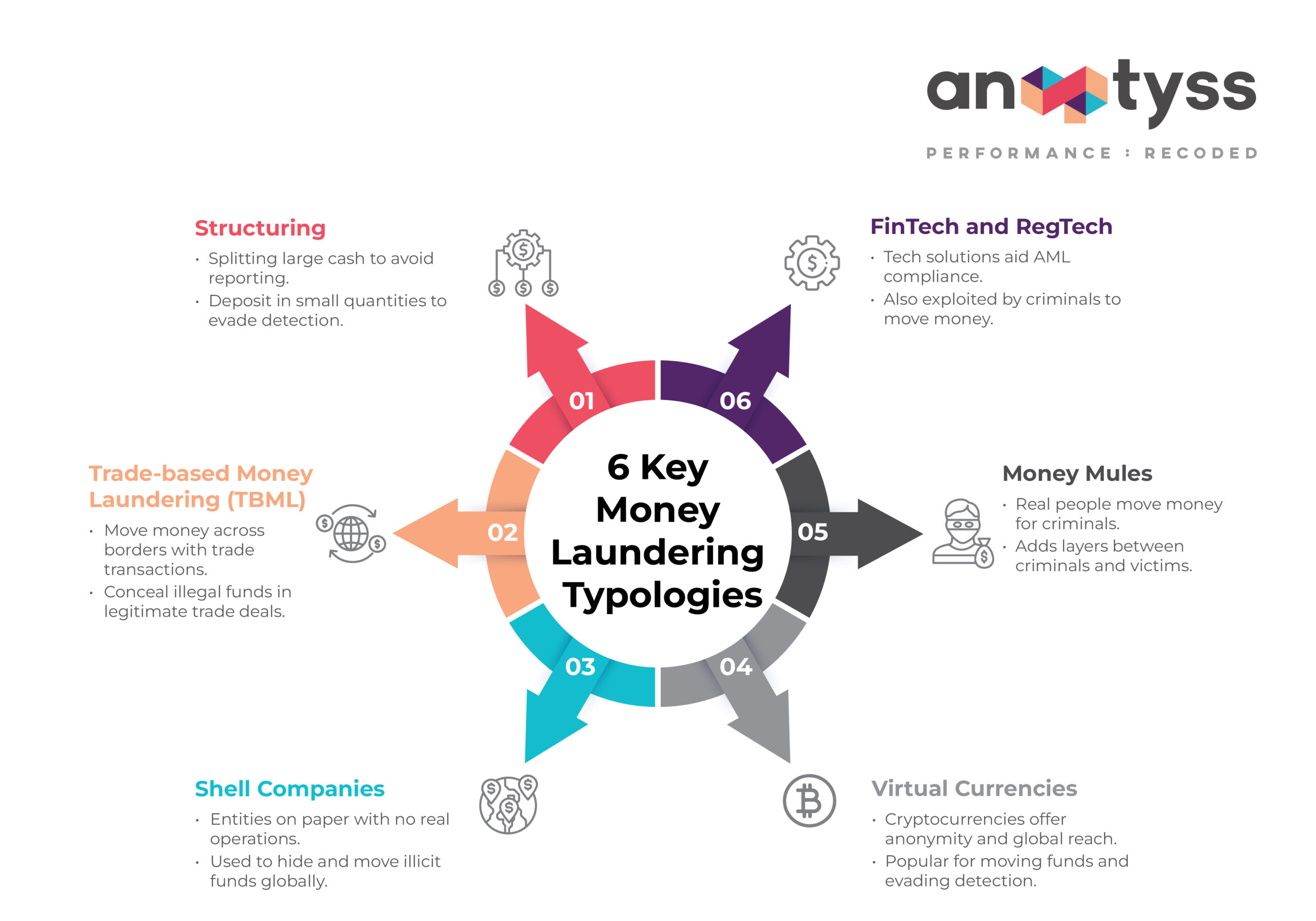This blog delves into the diverse typologies of money laundering and the sophisticated methods criminals use to disguise illicit funds. It highlights how banks can combat these practices through advanced technologies like AI and machine learning, enhanced due diligence, and collaboration with data sources. Implementing these strategies is crucial for effective AML/BSA compliance and maintaining financial integrity.
Money laundering is one of the most critical challenges faced by banks and financial institutions in the United States and other countries.
Money Laundering refers to the process of disguising the illicit money generated through criminal activities such as terrorist funding, drug trafficking, human trafficking, etc., as legitimate by hiding the origin, source, and ownership of the funds, making it appear to have been generated from a legal source.
Criminals employ various sophisticated money laundering typologies to evade detection and make it difficult for banks and financial institutions to identify and report suspicious transactions. Thus, banks and financial institutions must learn about the different types of money laundering typologies to develop effective strategies to identify and prevent money laundering activities.
In this blog, we discuss money laundering typologies and how banks can prevent, detect, and address these typologies to effectively combat money laundering activities and meet AML/BSA compliance.
Types of Money Laundering Typologies
Criminals use several types of money laundering typologies that banks and financial institutions should know. These typologies include:
1. Structuring
Structuring, also referred to as “smurfing” or “structuring transactions,” is a type of money laundering typology that entails avoiding reporting requirements by splitting large cash and depositing them in a series of small quantities. Criminals often utilize this typology to evade detection and scrutiny by institutions and law enforcement.
2. Trade-based Money Laundering
Trade-based money laundering (TBML) is a type of money laundering that involves the use of trade transactions to move money across borders and conceal illegal funds.
Banks must be vigilant when dealing with trade transactions and improve their due diligence procedures, closely monitor trade transactions, collaborate with other stakeholders, and monitor and detect any signs of suspicious activity.
3. Shell Companies
Shell companies are entities that exist only on paper. They have no real address, business, assets, or operations. Criminals use these shell companies to hide and move their illicit funds across borders.
Banks must have effective due diligence processes in place to identify and be aware of the risks associated with shell companies. Banks and financial institutions must identify the individuals behind the companies, linked assets, and their business operations.
4. Use of Virtual Currencies
Money laundering using virtual currencies and cryptocurrencies has become increasingly popular among criminals as they offer a high level of anonymity, decentralization, and global reach, making them one of the most popular instruments for criminals and money launderers. They utilize cryptocurrencies to move their illicit funds across borders at ease and infiltrate traditional financial systems while evading detection.
5. Money Mules
Money mules are real people who physically move illegitimate money on behalf of someone. Criminals often recruit money mules to launder their illicit proceeds. These money mules are used to add layers between the criminals and the victims, making it harder for law enforcement to catch the culprit. In today’s digital banking age, criminals are also leveraging money mules to digitally transfer illicit money using digital accounts and wallets.
6. FinTech and RegTech
In addition, the rapid expansion of financial technology (FinTech) and regulatory technology (RegTech) solutions presents banks with both opportunities and obstacles in their way to meeting AML obligations. Although both FinTech and RegTech technologies help improve the AML compliance program efficacy and efficiency, they are also being used by criminals and syndicates to move their illegitimate money.
How Banks Can Prevent, Detect, and Address Money Laundering Typologies
As the complexity and sophistication of money laundering schemes increase, banks also need to employ innovative strategies and technologies to strengthen their AML compliance capabilities. These strategies include:
1. Artificial Intelligence, Machine Learning & Data Analytics
By implementing modern technologies, such as machine learning and artificial intelligence with data analytics, banks and financial institutions can make their AML compliance programs more efficient and effective. These technologies enable banks to process and analyze large volumes of customer and transaction data to precisely and accurately identify patterns and detect potential money laundering typologies.
Machine learning algorithms can be trained to automatically recognize the common patterns and schemes linked with money laundering activities and fraudulent transactions and reduce false positives.
Similarly, banks can implement Natural language processing (NLP) techniques to analyze unstructured data, including customer activities on social media, and their communications to gain insights into their behavior and risk profiles.
2. Collaborate with Multiple Data Sources and Information Sharing
Collaboration and information exchange is crucial for institutions to remain ahead of the most recent trends and hazards associated with money laundering. This includes exchanging knowledge, intelligence, and best practices with other institutions, regulators, law enforcement agencies, and industry associations.
In the fight against money laundering, public-private partnerships (PPPs) and information-sharing platforms, such as the Joint Money Laundering Intelligence Taskforce (JMLIT) in the United Kingdom and the Financial Crimes Enforcement Network (FinCEN) Exchange in the United States, can aid in fostering cooperation and coordination among stakeholders.
In addition, banks can collaborate with FinTech and RegTech firms to develop and implement innovative AML solutions, such as blockchain-based transaction monitoring systems and AI-powered customer due diligence platforms.
3. Enhanced Due Diligence (EDD)
EDD is a critical component of the Know-Your-Customer (KYC) process that involves gathering information and data about the customer or entity for a higher level of identity assurance. It also involves additional reviews and investigations on high-risk customers, large transactions, or jurisdictions.
Banks should consider implementing EDD KYC measures as they are more rigorous and robust than the Customer Due Diligence (CDD) KYC process and helps better understand, evaluate, and manage the risks associated with a high-risk customer onboarding.
Conclusion
Combating money laundering activities requires banks and financial institutions to stay up-to-date with the latest trends, techniques, and threats employed by criminals to wash out their ill-gotten funds. In addition, banks also need to maintain a strong compliance culture and implement innovative digital solutions to effectively prevent, detect, and report money laundering activities to the regulatory bodies. This can help them protect their reputation and meet various AML regulations and guidelines based on FATF directives, BSA, and more.
Anaptyss is helping banks and financial institutions in the United States by leveraging ALFA and deep-domain expertise. ALFA is our enterprise-grade solution that offers real-time transaction monitoring, KYC risk profiling, watchlist screening, and alerts investigation to help banks and financial institutions mitigate financial crimes and fulfill their AML obligations.
Interested in knowing how the ALFA and domain-led expertise can help your financial institution address this? Read our success story & write to us: info@anaptyss.com.



















